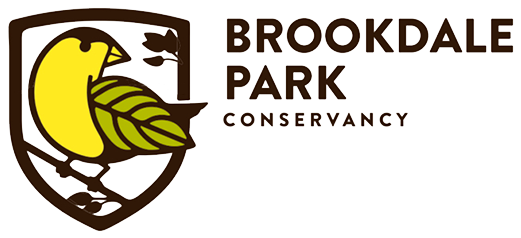by Evan Cutler
My first introduction to the raptors of Brookdale Park took place on a mid-September afternoon, shortly after we moved to Montclair exactly twenty years ago this month. Our son was playing soccer at the stadium, and while most of the parents were focused on the scrimmage taking place on the field, I was distracted by a much different activity high overhead. An adult Red-tailed Hawk was circling the sky, slowly moving closer and closer to our section of the bleachers. As a lifelong birder, I took particular interest in this bird, which nobody else seemed to even notice. That is, until maybe five minutes later when I suddenly heard a scream. A group of parents sitting just a few rows up from the end zone spotted the hawk as it landed on the track, carrying a gray squirrel in its talons, which it proceeded to quickly devour. The parents watched in horror, clearly unprepared for this circle-of-life moment playing out just yards away.
Red-tailed Hawk
photo credit: Wayne Quinto
Turns out this bird was actually one of the resident Red-tailed Hawks that nest in the park each year (this past summer, a pair nested just north of the dog park near the top of a tall oak). While this is the only species of hawk that nests inside the park, in the fall, Brookdale Park is a terrific place to spot migrating raptors of all types. Hawks, falcons, eagles and vultures begin their southerly migration in early September. Many of them are following the nearby Watchung Ridge. In fact, the Montclair Hawk Lookout–just two miles west of the park–is the country’s second-oldest continuous hawk watch. And these birds passing through need to refuel often during their long journey. That’s why you’ll see so many of these birds here in the park through much of autumn. Beginning in late August, the American Kestrel, our smallest falcon, can often be found catching dragonflies and other insects on the wing above the meadow. We also see plenty of Merlins hunting in the park. The Merlin is also a falcon, larger than a Kestrel but smaller than a Peregrine Falcon. They can often be found perched in one of the tree snags just south of the dog park as they hunt for songbirds. Sharp-shinned Hawks and Cooper’s Hawks also love hunting for birds. These two species of Accipiters can be found year-round in the area, but during migration their numbers explode. On a good day with winds from the northwest, we can see dozens of these birds pass through the park.
American Kestrel
photo credit: Wayne Quinto
Peregrine Falcon
photo credit: Wayne Quinto
But for sheer volume, nothing compares to the flight of the Broad-winged Hawk in mid-to-late September. Last year at the Montclair Hawk Lookout, a total of nearly 10,000 Broadwings were counted during a particularly busy three day stretch from September 21st to 24th. And many of these birds flew directly above Brookdale Park. Unlike most raptors, broadwings migrate in large flocks called “kettles,” that range in size from just a few birds to several thousand. Take a look up in the sky during the first two weeks of October and you’ll often see a cloud of birds circling high above, swarming like bees near a hive. These Broad-winged Hawks are riding the thermals–using the rising hot air generated by the sun to glide from one thermal to the next as they work their way south to their winter territory in Central and South America. If you’re in the park on a day after a cold front when there are favorable winds from the north (ideally northwest winds), you’ll often see them directly overhead.
Broad-winged Hawk
photo credit: Wayne Quinto
My other favorite raptor often seen above the park is the Turkey Vulture. They also can be spotted in large groups. You can tell them apart from other raptors by the way they fly. As they soar, their large wings are actually slightly above their bodies–forming a “v” or a “dihedral” as birders call it. Vultures eat carrion and have incredible eyesight, as well as a keen sense of smell. They can spot road kill up to two miles away–which is why you’ll often see them along highways. But I’ve also seen plenty of vultures in the park–a reason why a rodent run over by a car often doesn’t last very long before it is lunch for one of these birds.
Turkey Vulture
photo credit: Wayne Quinto
As you may imagine, I can probably go on all day talking about raptors. I consider myself so fortunate to have a park so close to home where so many of these incredible birds can be found. And perhaps the best thing about birding is that you never know what you might see on any given day–which makes for a perfect excuse to visit Brookdale Park as often as you can this fall season. And remember to look up!
Family Activity:
Peak bird watching is happening now. Check out Montclair Bird Club for upcoming programs and field trips.
Suggested Reading:
The Sibley Field Guide to Birds of Eastern North America
By David Sibley
Watching Birds in Montclair
By Sanford Sorkin and Rick Wright
Available at Watchung Booksellers
Evan Cutler is a resident of Montclair and is President of the Montclair Bird Club.







